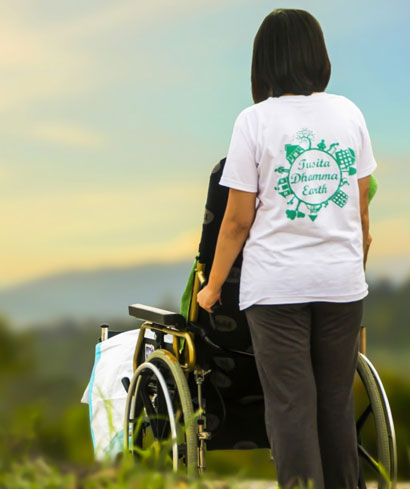Joint diseases affect a large number of older people. Pain and stiffening of joints and muscles can seriously affect your mobility. Your doctor may be able to prescribe drugs to relieve your symptoms, a physiotherapist can give help with special exercises and an occupational therapist can give advice on mobility aids and on protecting your joints. Your doctor should be able to refer you to a physiotherapist or an occupational therapist for this type of help
MOBILITY AIDS
If you are having problems getting about, there are many different kinds of “mobility aids”. If you find a right one for you, you may regain much of your independence. The simplest mobility aid is a walking stick, which can be helpful if just one of your legs needs extra support. If both your legs need support, then you may need to use two walking sticks, a walking frame or a rollator. If you find it difficult to walk at all, then you may need a wheelchair.
It must be ensured that your walking stick is of correct length. It should be level with the wrist crease when your arm is held by your side. If two walking sticks are being used to give balance, they need to be longer because they will be held in front of you. A walking stick should have a rubber at the end which would prevent it from slipping. They wear out quickly so they need to be checked regularly. Walking frames give even more support, are stable, and help increase confidence. Rollators are wheeled frames which are easier to manoeuvre. They are good for people with moderate balance problems.

ARTHRITIS AND PAIN KILLERS

Arthritis or inflammation of the joints is a common problem in advancing years and is one of the three most common health problems in older people.
There are several types of arthritis, among which osteoarthritis is the most common. Osteoarthritis, strictly speaking, is not an inflammatory condition but an age-related degenerative disease. This condition strikes the weight-bearing joints of lower limbs, neck and back along with those of the hands. Pain may come and go and can vary from mild to severe. Most forms of arthritis are neither preventable nor curable. The goal of treatment of arthritis is to relieve pain and restore the functions in the affected joints. Treatment schedule of arthritis includes rest, weight reduction, physiotherapy, exercise and drug therapy to relieve pain.
Arthritis medicines are among the most commonly used medicines by older people. Among all pain killers non-steroidal anti-inflammatory drugs (NSAIDs) are the ones most frequently prescribed. These drugs block the production of chemicals in the body that cause pain, stiffness and swelling. It often takes from a few days to a week before NSAIDs start to work and 2 to 3 weeks before the full benefits of treatment are felt
Some of the most frequently used NSAIDs are listed below. Most of these pain-relieving drugs have similar effect and side-effects.
| Generic name | Brand name |
|---|---|
| Aspirin | Disprin |
| Nimesulide | Nimulid, Nise |
| Meloxicam | Melflam, Mcam |
| Ibuprofen | Brufen |
| Diclofenac | Voveran |
| Piroxicam | Pirox |
| Paracetamol | Crocin, Calpol |
| Celecoxib | Celact, Revibra |
SIDE-EFFECTS OF NSAIDS
Along with the much-needed pain relief, NSAIDs may cause unwanted side-effects in some people. The side-effects include stomach ulcers, heartburn, nausea, stomach pain, vomiting, diarrhoea, and gastrointestinal bleeding. Gastrointestinal bleeding can manifest as blood vomiting or black stools. NSAIDs can also cause headache, dizziness and blurred vision.
You must report to your doctor if you develop any of these symptoms. In some cases, it may be necessary to adjust
the treatment in order to keep the side-effects to a minimum.
To reduce the side-effects, NSAIDs should be taken after food. In addition, an anti-ulcer drug, omeprazole (brand name Omez, Ocid, Protoloc) prevents stomach ulcers. NSAID-induced stomach problems are more common in smokers and alcoholics.
CORTICOSTEROID
Corticosteroid also reduces inflammation in some types of arthritis. Taken orally or injected into the inflamed joint, corticosteroid rapidly reduces the inflammation and relieves pain temporarily.
Corticosteroid, however, has serious side-effects which include reduced resistance to infection, indigestion, weight gain, loss of muscle power, mood changes, blurred vision, cataract, diabetes, brittle bones (osteoporosis) and high blood pressure. Corticosteroid is a very useful medicine but should only be taken under medical supervision.
UNPROVEN REMEDIES
People with chronic arthritis often explore alternative systems of medicine. Several pills, gadgets and diets have been suggested as cure for arthritis. Because arthritis pain can come and go, many people believe that these cures really work. You should be careful of any pill or device that promises miracles as most arthritis is incurable.